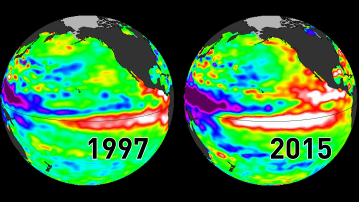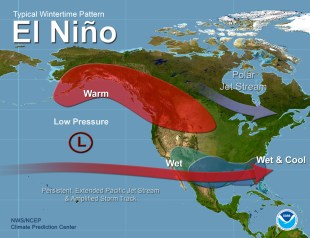If you’re like millions and millions of mildly quizzical Americans, you have probably found yourself wondering: “Hey, just what is El Niño, anyway?” in the recent weeks or months. The scientific and meteorological communities are abuzz with chatter about this relatively rare weather phenomenon, and their excitement has leaked into the media and then into the collective semi-conscioussness* of the nation… but what is it?
Related: Winter Weather and Your Car
Well, don’t listen to me prattle on when we can instead get the 4-1-1 from the late great Chris Farley!
OK… fine comedy notwithstanding, that video offers little in the way of explanation. Sigh… looks like I’ll have to go ahead and explain this myself after all.
Simply put, El Niño is the name given to an interrelated atmospheric and oceanic phenomenon wherein unseasonably warm water in the Pacific Ocean leads to more rainfall across North America. Less simply put, it is the warmer phase of the El Niño-Southern Oscillation (or ENSO… thank you very much National Oceanic and Atmospheric Association!) cycle. There is a standard cycle of temperature fluctuations between the ocean and atmosphere, but sometimes they get a bit more… dramatic, shall we say.
Here’s the breakdown…

See how warm those patches of water look there back in 1997 and again during this 2015-2016 winter? Yep, that’s what happens when the lazy trade winds slack off. (For shame, lazy, shirk-a-day trade winds.) That warmer water ends up leading to greater than usual evaporation which in turn leads to increased levels of precipitation (that’s rain and snow. And sleet. And hail).

And of course while more water than usual is falling across North America, less water falls in other parts of the world. So while there are downpours and floods here, there are often droughts in other places such as India and Indonesia. This reduced rainfall can result in extreme food shortages and greatly increased risk of wild fires, both of which, in scientific terms, suck.
But why is it called El Niño?
Ah! Great question! I’m glad… that I assumed you asked it, and therefore posed the question myself… on your behalf.
Anyway…
The weather phenomenon today universally referred to as El Niño was given its name by fishermen plying the waters of the western coast of South America. The warmer waters disrupted the health of the fisheries, lowering the annual catch and impacting the local economy. As this always tended to happen near the Christmas season, the fishermen began to refer to the occurrence as El Niño, which in English means The Child, which refers to none other than The Christ Child.
So… if El Niño rains/droughts/floods/snow ruin your crops/day/commute/life, you can go ahead and just say:
Jesus Christ
__________________________________________________________________
*That is not a term, nor would this be a correct use of the correct term “collective consciousness,” just FYI.



